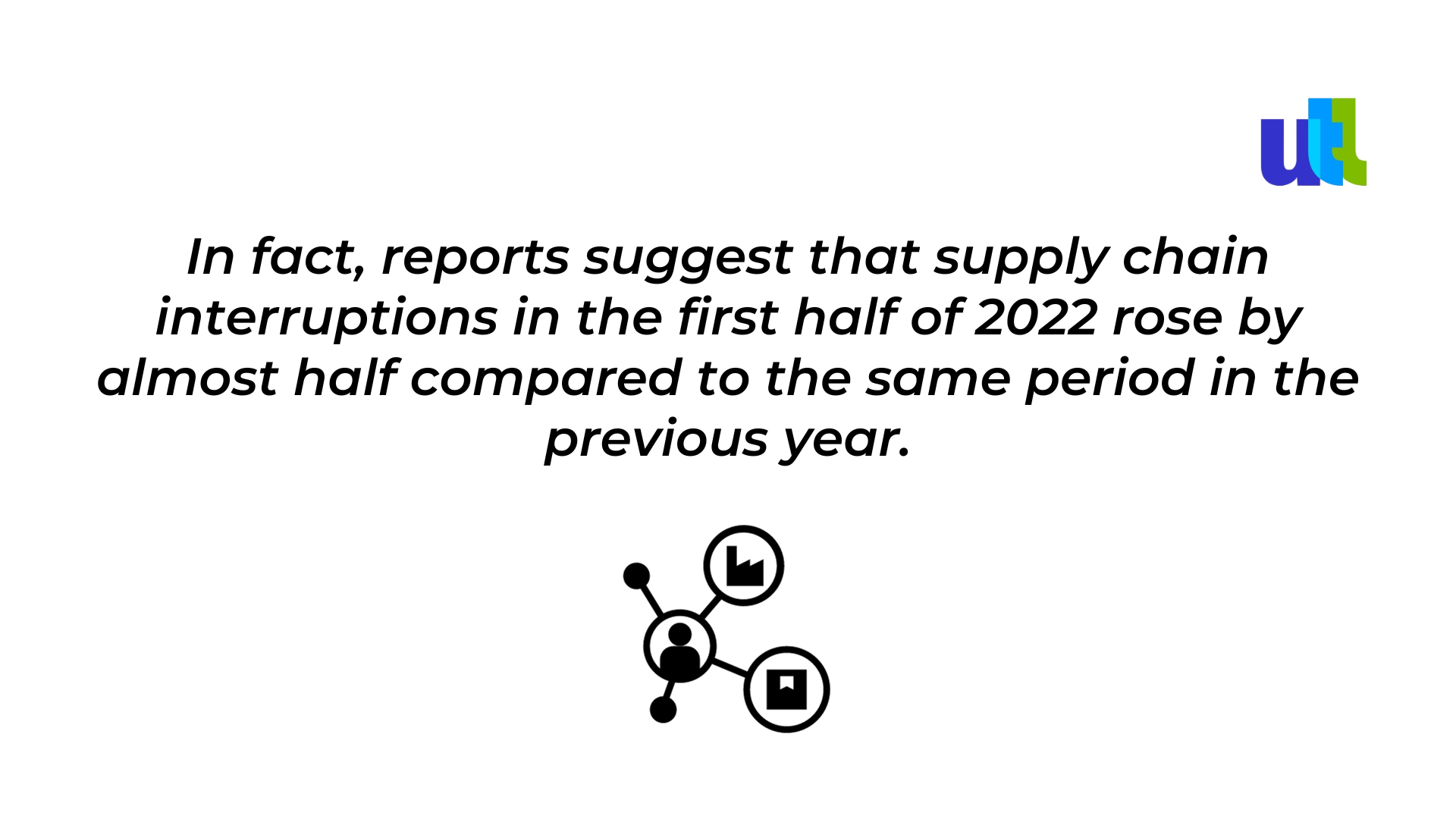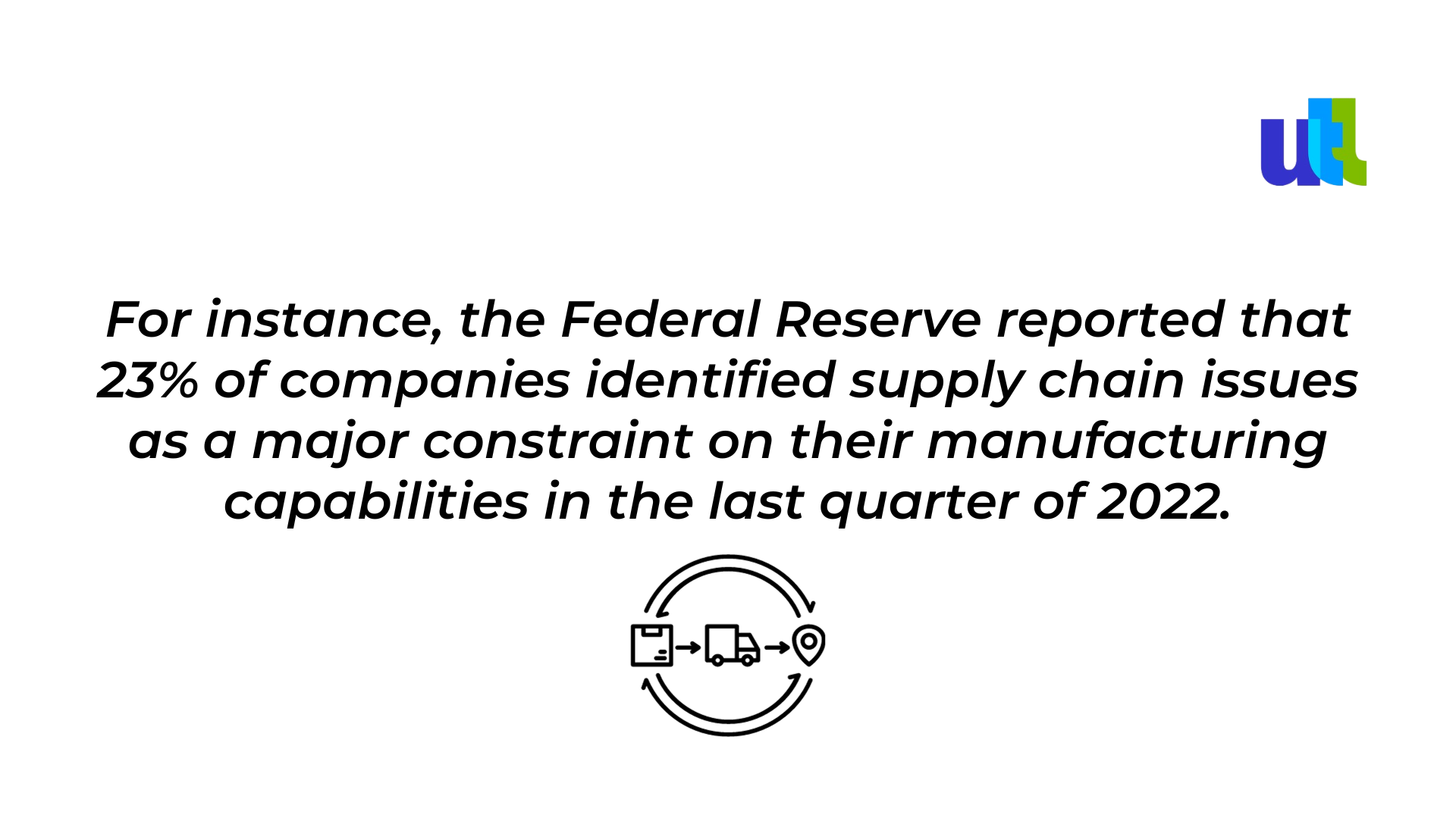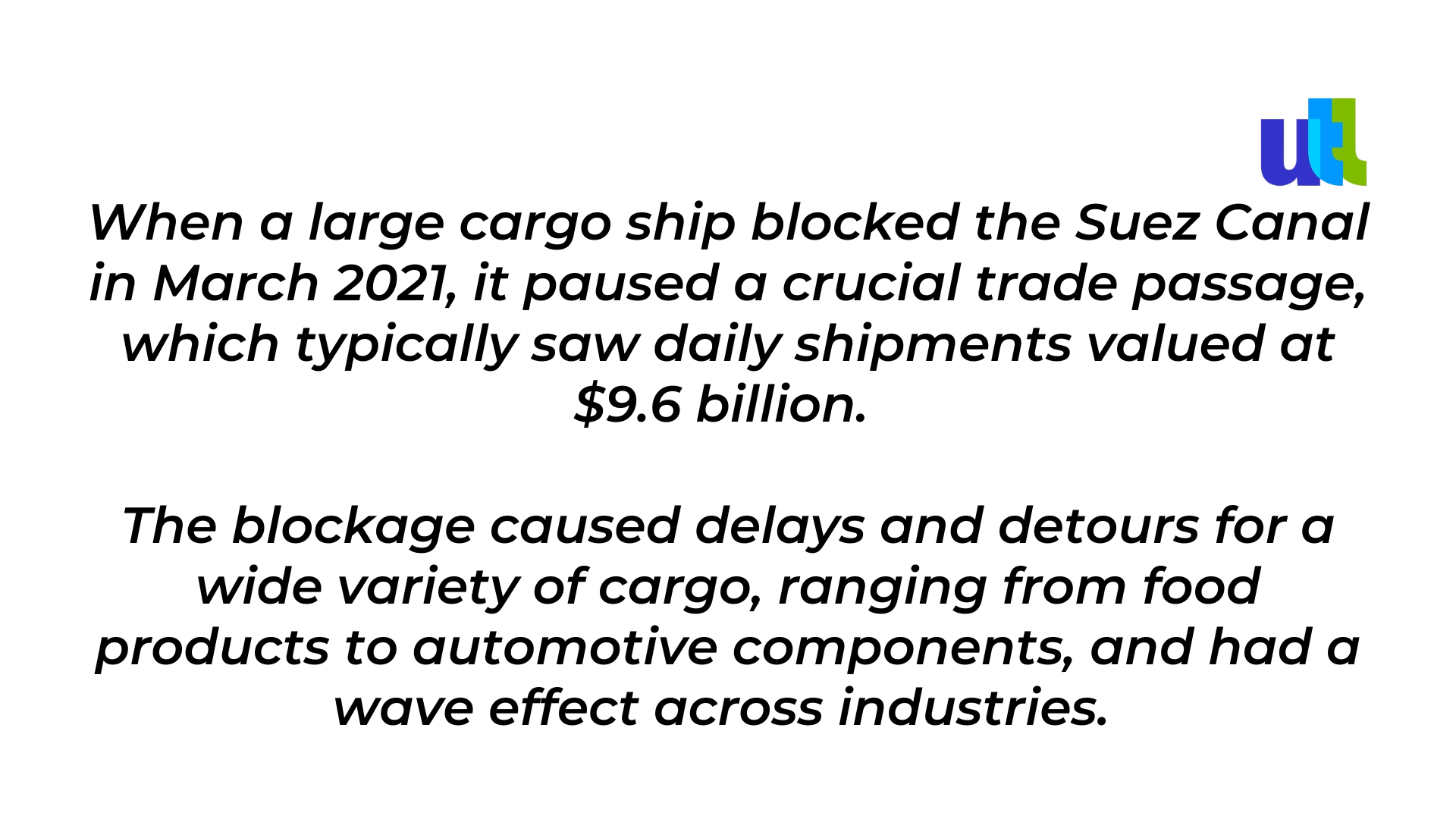The importance of a resilient supply chain has become more evident than ever in the wake of global events that have shaken the stability of businesses worldwide. Companies are now reevaluating and reinforcing their supply chains to withstand various challenges, from lingering pandemic impacts to new, unforeseen complications. This blog post aims to provide clear, actionable strategies for businesses looking to minimize disruptions in their supply chains, especially in environments where risk is a constant. With issues like labor shortages, transport delays, cyber threats, severe weather, and inflation adding to the uncertainty of market demands, it's essential for businesses to prepare for the next possible disruption.
What Is a supply chain disruption?
A supply chain is essentially the system that encompasses all the individuals, businesses, and activities involved in producing a product and delivering it to the consumer. Any event that interrupts this flow—whether it's in manufacturing, distribution, or sales—is known as a supply chain disruption. These disruptions can slow down shipments, reduce product quality, lead to higher costs, and tarnish a company's reputation.
During the peak of the pandemic, supply chain issues became headline news as breakdowns in the system resulted in empty supermarket shelves and hard-to-find items, causing frustration over delayed deliveries. While some of the shipping disruptions and cybersecurity incidents that were prevalent from 2020 to 2022 have eased off, they haven't vanished, and new problems have emerged, like oil price hikes and shortages of electronic components.

These supply chain difficulties can significantly affect a company's overall performance. To manage these risks and reduce the impact of such disruptions, businesses might implement various strategies. These can include setting up alternative supplier arrangements, reconfiguring the geographic layout of supply chains, or increasing their stock levels. Digital tools are aiding these strategies by improving networking with suppliers, increasing the visibility of the supply chain, and enhancing data analysis. This enables businesses to keep a close watch on their supply chains, identify potential issues early, and plan accordingly to prevent costly problems.
Internal risks: These are risks that originate from within a company and can include issues like poor inventory management, inadequate supplier relationships, lack of backup plans, or insufficient oversight of the supply chain. For instance, if a company's leadership introduces a new business strategy that overlooks the supply chain's needs, it could lead to disruptions. Internal risks often stem from the company's own decisions and practices.
External risks: These come from outside the company and can be harder to manage since they're beyond the company's direct control. Examples include natural disasters, cyberattacks, port blockages, political unrest, or even market demand shifts. An external risk could involve a political crisis in a country that's a source of goods, affecting the supply chain indirectly. External risks also include disruptions at any tier of suppliers, which are especially complex when they involve international trade.
Supply chain risks
Every aspect of the global supply chain carries certain risks that can influence a company's performance, reputation, and financial health. If not properly managed, these risks — both internal and external, known and unknown — can lead to significant setbacks.
Before we explore the best practices for managing these risks, it's crucial to understand the nature of the two main categories of risks.
Disruptions in the supply chain are a top concern for executives and board members due to their potential to impact business operations severely.

To grasp the severity of these disruptions, consider the extreme scenario

Even after the ship was freed, legal complications led to it being held for months, with experts suggesting the incident had lasting global supply chain effects over a year later.
The consequences of supply chain disruptions are diverse, including rising costs, cancelled orders, lower profits, and decreased market value for companies.
Understanding the landscape of supply chain disruptions: Pandemics, natural disasters, and more
Supply chain disruptions remain a significant concern for businesses. These disturbances come from various sources:
- Global Pandemics: Disruptions such as COVID-19 can ripple through supply chains, causing shortages and altering consumer demand. Businesses are adjusting by stocking up and shifting strategies to be more resilient, including digital enhancements and closer supplier proximity.
- Natural Disasters and Extreme Weather: Events like storms and droughts can interrupt supply chains and are expected to increase in frequency. Companies are using advanced planning and technology like AI to predict such events and create contingency plans.
- Labor Shortages: A lack of available workers, especially in transportation, is causing delays and operational challenges. Automation is one solution being employed to alleviate the pressure by enabling existing workers to focus on higher-level tasks.
- Transportation Delays: These delays are often due to labor issues, weather, customs, or even geopolitical tensions. Businesses are advised to manage inventory closely across departments to mitigate these delays.
- Price Volatility: Inflation and energy costs are causing price fluctuations, leading businesses to use digital tools for better cost visibility and predictive analytics to anticipate and manage changes in pricing.
- Cyberattacks: With an increase in sophisticated cyber threats, businesses are enhancing cybersecurity measures and collaborating with supply chain partners to manage third-party risks.
In addition to these, product quality issues are a key concern, with businesses needing to ensure quality management throughout the supply chain to avoid sending defective products to customers. Managing these risks requires strong communication and understanding of vulnerabilities within the supply chain.
Navigating supply chain turbulence: Strategies for resilience
In an environment where supply chain disruptions are a constant, businesses are learning to navigate this rough terrain to maintain a competitive edge. Best practices for resilient supply chains involve a multi-faceted approach:
Risk identification and digital monitoring: Managers must catalog known risks, such as supplier bankruptcies, and consider unpredictable factors like fluctuating interest rates. Tools like predictive analytics and real-time digital monitoring systems help uncover hidden risks and track ongoing disruptions.
Contingency planning: Agile operations require backup supplier relationships and alternative strategies. A dynamic contingency plan involves steps to identify disruption causes, prioritize critical operations, manage inventory, and maintain clear communication with stakeholders.
Visibility through technology: Technologies such as cloud computing and the Internet of Things enhance visibility across the supply chain. Companies use digital tools for real-time tracking and maintenance, helping predict stock shortages and expedite orders.
Automation and efficiency: Automation in warehouses and transport, complemented by robotic process automation and AI, increases efficiency and reduces the risk of errors. This technology ensures timely reordering and rerouting of goods to prevent delays.
Regular reviews and updates: Supply chain strategies should not be static. Regular reviews and updates to risk mitigation plans, using scenario planning exercises, ensure that strategies evolve with the changing global landscape.
Preventive measures: Building up inventory, conducting vulnerability audits, identifying backup suppliers, and partnering with logistics experts are all preventive measures that can mitigate a company from the impact of disruptions. Technology plays a key role here as well, with AI-enabled tools and environmental analysis solutions providing a deeper understanding of potential threats.
In summary, effective supply chain management today means preparing for the unexpected with a robust plan that encompasses risk identification, contingency strategies, technological visibility, automation, supplier relationships, and constant evolution and reassessment. These strategies help businesses remain competitive and resilient in the face of ongoing supply chain volatility.
Handling supply chain disruptions: Immediate actions and long-term strategies
When a supply chain disruption strikes, businesses must act swiftly to mitigate the impact and maintain operations. Here’s a guide for managing acute supply chain issues:
Immediate Communication: Start by being transparent with customers about any delays or stock issues. Regular updates across various channels, including your website and emails, can preserve customer trust during disruptions.
Supply Chain Evaluation: Pinpoint the most critical elements of your supply chain. Identify alternative sources for essential parts and prioritize establishing these new supplier connections to minimize operational interruptions.
Inventory Assessment: Keep a precise count of your inventory, both finished products and components, to understand your capacity to fulfill orders and maintain production.
Behavioral Analysis: Monitor consumer behavior changes that affect demand for your products, and if necessary, pivot your offerings to align with current market needs.
Business Continuity Planning: Develop a business continuity plan focused on prevention, preparedness, response, and recovery to protect operations during disruptions.
Proactive Supplier Management: Regularly assess risks related to your suppliers and establish a cross-functional team for ongoing risk management.
Cybersecurity Vigilance: Set compliance standards for all vendors and regularly update your disaster recovery plan and cybersecurity measures to shield against digital threats.
Environmental Risk Management: Although unpredictable, have strategies in place for environmental risks, including diversifying suppliers and nearshoring to reduce development and delivery times.
Freight Carrier Monitoring: Maintain rigorous oversight of freight carrier performance metrics to ensure reliable delivery timelines.
Risk Scenario Modelling: Utilize predictive analytics to prepare for potential risks, helping you to identify vulnerabilities and prepare for disasters before they occur.
Invest in Supply Chain Software: Employ advanced software with analytics and artificial intelligence to automate and streamline risk management processes.
In a landscape where supply chain disruptions have become a norm, integrating these strategies can significantly reduce their impact. Businesses must adopt a proactive stance, utilizing digital tools, fostering strong supplier relationships, and maintaining a flexible, well-informed approach to supply chain management.
Conclusion
In conclusion, supply chain disruptions are a certainty in the unpredictable theater of global commerce. Whether spawned by the forces of nature or human conflicts, these interruptions demand anticipation and strategic planning. Manufacturers who thrive are those who anticipate the unexpected, craft flexible responses, and execute continuity plans that shield their customers from the brunt of the fallout. The essence of navigating these disruptions lies not only in agility and visibility but also in the resilience built into every link of the supply chain. By weighing the costs against the benefits, companies can fine-tune their strategies, ensuring they are well-equipped to withstand disruptions and emerge from challenges with their operations intact and customer trust preserved.
For free consultation on supply chain disruptions, click here.
----------------------------------------------------------------------------------------------
View the full presentation:
WRITTEN BY
Milda Butkeviciute
2023-11-28


































































































































































































